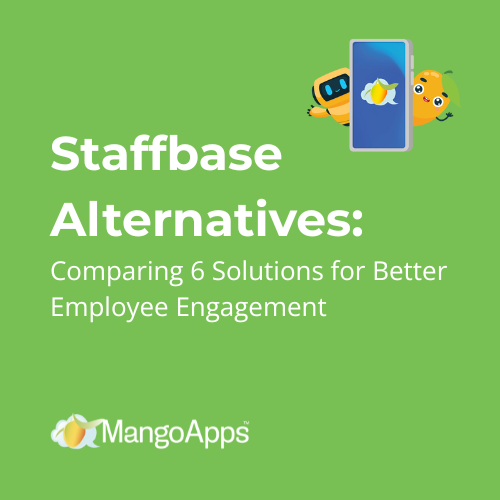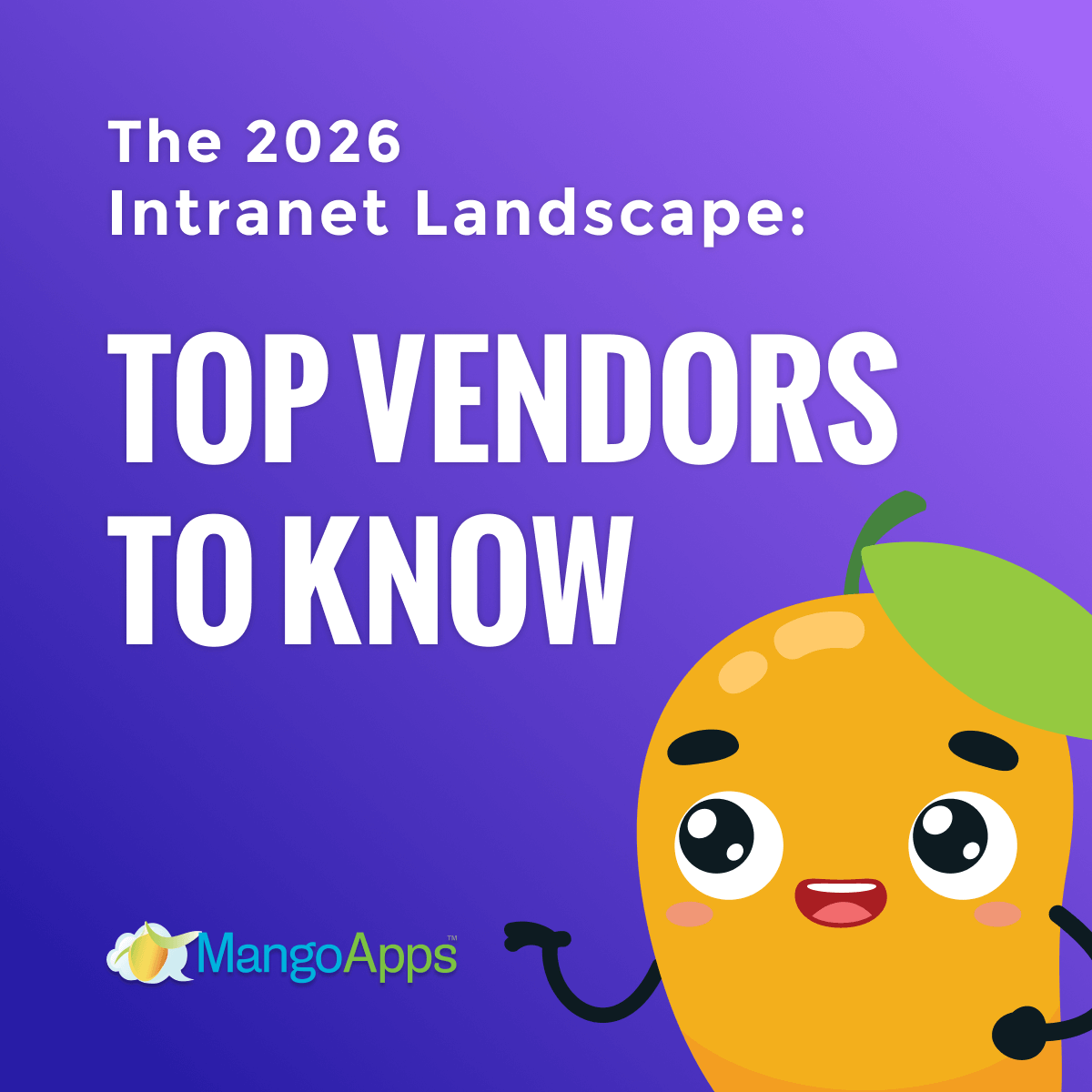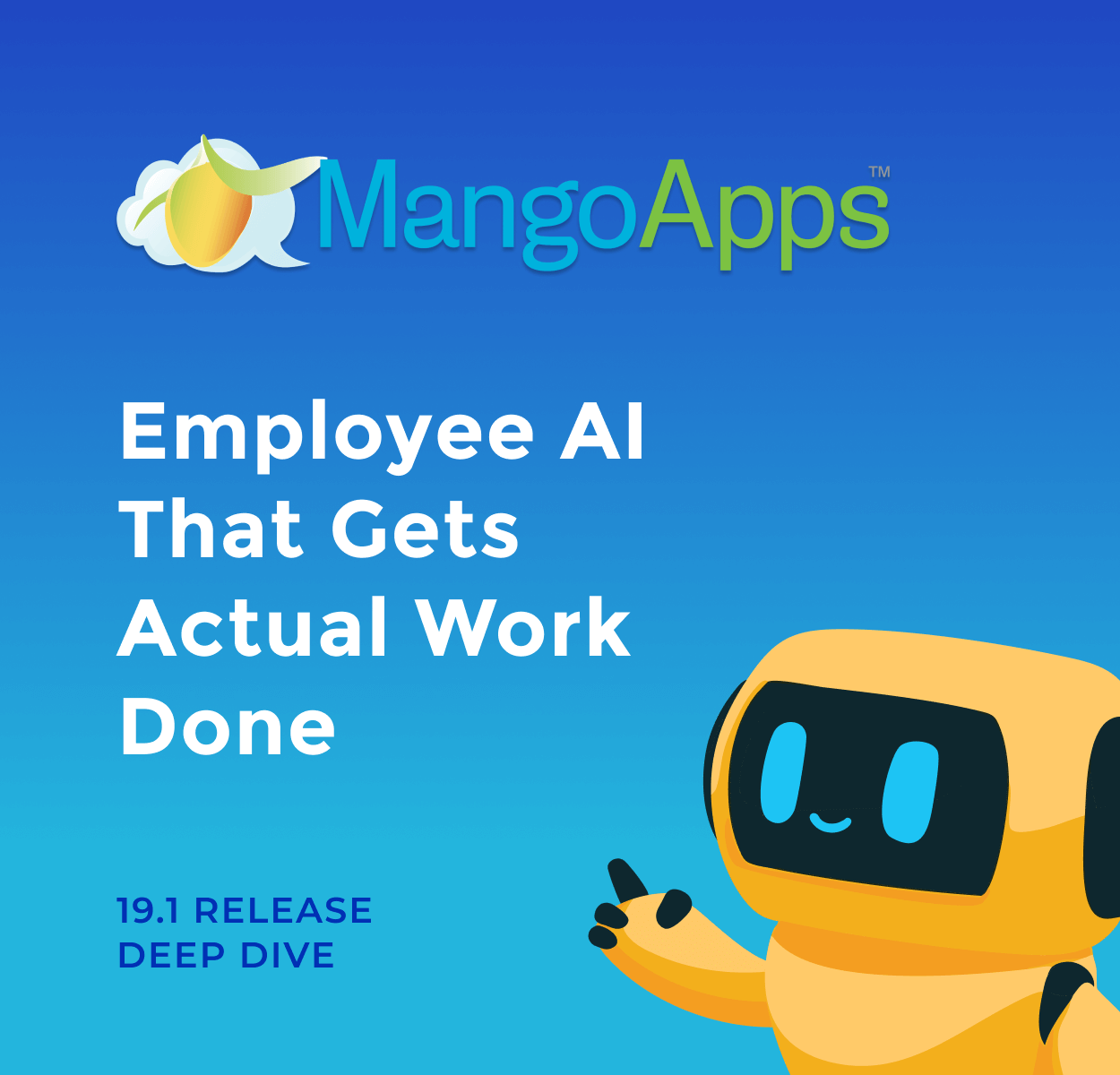
For years, Simpplr has been a familiar name in intranet software, known for its clean interface and social-style communications. But as workplace technology evolves, many enterprises have discovered that simplicity alone isn’t enough. Rising costs, limited support for frontline teams, and a lack of advanced AI and workflow integration leave many organizations searching for stronger, more unified alternatives.
A modern intranet in 2025 must do more than host news and updates. It has to connect communication, knowledge, and daily work in one governed platform—secure, intelligent, and accessible to every employee. That shift has moved the market toward AI-powered intranets, where content is generated, answers are contextual, and frontline employees have the same digital access as their office-based peers.
Industry data shows why this transformation matters. The intranet software market is projected to grow from $18.8 billion in 2024 to nearly $49 billion by 2031 (Verified Market Research), driven by demand for unified employee experience platforms. Yet usage remains uneven: 91 percent of organizations have an intranet, but only 13 percent of employees use it daily, and nearly one-third never log in at all (Social Edge Consulting 2025). The gap between ownership and engagement reflects a deeper truth—many intranets still function as digital noticeboards rather than intelligent workplaces.

AI is now the differentiator. According to McKinsey’s State of AI Global Survey (2024), three-quarters of enterprises use AI in at least one business function, and 80 percent have adopted generative AI. However, only 10 percent of organizations use AI inside their intranets today, and just 17 percent are in pilot programs (Arctus Observatory of the Augmented Intranet 2025). The companies that do are seeing measurable gains: faster time-to-answer, fresher content, and higher adoption across deskless and desk-based employees alike.
MangoApps leads this evolution. Recognized as a Leader in the IDC MarketScape: Employee Experiences for Integrated Workspaces (2025) and a Visionary in Gartner’s Magic Quadrant for Intranet Packaged Solutions, MangoApps delivers the first AI-powered intranet built for the entire workforce. It unifies communications, knowledge, and operations through one intelligent platform—powered by Mango Employee AI, 200 + integrations, and enterprise-grade security (SOC 2, GDPR, HITRUST).
Before exploring the leading alternatives to Simpplr, it helps to understand the criteria that now define a strong intranet in 2025:
- Intelligent search and automation that make information instantly accessible.
- Enterprise-grade compliance and security that protect every interaction.
- Seamless integration with HR, operations, and productivity systems.
- Mobile access and AI-powered personalization that include the frontline, not just the office.
The comparison below evaluates eight platforms that organizations commonly consider when looking beyond Simpplr—and shows how each measures up against these new expectations.
Comparing the Leading Simpplr Alternatives
When evaluating intranet software for 2025, most organizations are focused on three essentials:
- Intelligent AI and knowledge search that save time and reduce frustration.
- Security and compliance frameworks that meet enterprise standards.
- Seamless integrations with HR, operations, and productivity systems.
The reality is that few platforms deliver all three in a unified experience. Some excel in social engagement or content management but lack the depth of automation, governance, or extensibility that large enterprises now require. Others offer attractive user interfaces but depend on external systems to fill functional gaps.
MangoApps stands apart as the only solution in this group that brings every element—AI, security, and integrations—together within one platform. Its AI-powered intranet and employee app unites communications, HR, and operations data through a shared foundation known as the Employee Data Layer, giving leaders visibility and control that siloed tools can’t match.
The following table provides a high-level comparison of eight leading alternatives to Simpplr. Each platform offers its own strengths, but only MangoApps combines enterprise-grade security, AI-powered intelligence, and extensibility in a single, governed system.

How to Read This Comparison
While all eight vendors market themselves as intranet or employee experience platforms, their capabilities and architecture vary widely:
- MangoApps delivers a unified, AI-powered employee platform that consolidates intranet, HR, and operations in one governed hub.
- Workvivo, Staffbase, and Blink prioritize culture and communications but rely heavily on third-party integrations for deeper functionality.
- Unily and LumApps offer robust enterprise frameworks but often require extensive setup, customization, and Microsoft dependency.
- Beekeeper focuses on frontline access but with limited AI maturity.
- Interact excels in compliance-driven environments yet lacks the automation depth that newer AI-powered systems provide.
Across the board, AI maturity and extensibility are now the real differentiators. Platforms that simply add AI features risk fragmentation; platforms that are built on AI, like MangoApps, provide scalability, governance, and measurable business outcomes.
1. MangoApps

Best for: Enterprises that want a single, intelligent workspace connecting every employee, process, and resource.
Key Strengths of MangoApps:
- Unified platform: Combines intranet, collaboration, and HR tools into one governed system.
- Enterprise AI: Context-aware assistants that power search, content creation, workflows, and translation.
- Security & governance: SOC 2, GDPR, and optional HITRUST certification with fine-grained permissions.
- Integration depth: Over 200 prebuilt connectors plus an extensible app marketplace.
- Proven leadership: Named a Leader in the IDC MarketScape 2025 for Employee Experiences and a Visionary in Gartner’s Magic Quadrant for Intranet Packaged Solutions.
Unique Capabilities of MangoApps:
- Mango Employee AI: Provides real-time answers, document summaries, and automated task creation across the platform.
- Employee Data Layer: Centralizes data from communications, HR, and operations, enabling AI to deliver precise, contextual guidance.
- Governed automation: AI-powered assistants generate content, translate posts, and automate workflows while maintaining compliance controls.
- Cross-system visibility: Unified dashboards let leaders monitor engagement, performance, and workforce health in real time.
- Rapid deployment: Designed to launch in weeks, not months, reducing IT overhead and accelerating time-to-value.
For enterprises seeking measurable gains in productivity, engagement, and retention—not just incremental communication improvements—MangoApps delivers the complete AI-powered employee platform that connects every worker and every workflow.
2. Workvivo

Best for: Organizations prioritizing culture and engagement over operational integration.
Strengths of Workvivo:
- Intuitive, social-style intranet experience that emphasizes connection and recognition.
- Built-in live-streaming and integration with Zoom for interactive company updates.
- Simple design that drives quick adoption for communications-focused use cases.
Capabilities of Workvivo:
- Uses Zoom AI Companion for meeting transcription and summary generation, though AI is not natively embedded across the platform.
- SOC 2 compliant for basic data protection.
- Integrates primarily with Zoom and limited HR or collaboration tools.
- Lacks advanced governance, workflow automation, and federated AI search capabilities common to modern enterprise intranets.
While Workvivo can strengthen culture and engagement in smaller environments, it remains communication-centric. Organizations that require enterprise-wide visibility, automation, and secure AI-driven knowledge management will find MangoApps delivers broader and longer-term value.
3. Staffbase

Best for: Large enterprises with complex internal communication needs.
Strengths of Staffbase:
- Strong multi-channel communication features across desktop and mobile.
- Broad translation and localization capabilities to support global audiences.
- Reliable compliance foundation with ISO 27001 and GDPR certifications.
Capabilities of Staffbase:
- Offers an AI assistant to help communications teams draft and target posts, though functionality remains limited to specific use cases like content generation.
- Deep native integration with Microsoft 365 for content publishing and authentication.
- Analytics features provide basic engagement insights across posts and campaigns.
- Heavily dependent on the Microsoft ecosystem, which can constrain flexibility for organizations running hybrid stacks or custom environments.
While Staffbase provides a capable communication layer, it remains focused on content distribution rather than full digital workplace integration. It lacks the unified data model, AI-powered automation, and cross-system intelligence that enterprises gain with MangoApps. For organizations seeking a single platform for communication, knowledge, and daily operations—rather than managing multiple Microsoft-dependent tools—MangoApps delivers a more extensible, future-ready foundation.
4. Beekeeper

Best for: Frontline and operational teams that need a mobile-first communication tool.
Strengths of Beekeeper:
- Purpose-built for deskless workers with a clean, mobile-first experience.
- Supports shift management and operational communication in real time.
- Recognized for ease of deployment and adoption in industries like hospitality, logistics, and retail.
Capabilities of Beekeeper:
- Includes a simple AI assistant for automating routine frontline workflows and sending alerts.
- Certified for GDPR and ISO compliance.
- Integrates with frontline HR systems such as BambooHR and Workday, though broader enterprise integrations may require additional setup.
- Offers limited analytics and governance controls compared to enterprise-grade intranets.
Beekeeper recently announced a merger with LumApps, creating a combined entity focused on both frontline and desk-based communications. While the long-term vision is compelling, the merger introduces several unknowns for buyers:
- Unclear product roadmap: The companies have not clarified whether Beekeeper and LumApps will remain separate products or eventually consolidate into one platform.
- Potential feature overlap: Both products offer communication and content tools, raising questions about which capabilities will be maintained, merged, or deprecated.
- Support and migration plans: Details on platform migration paths, long-term support, and customer transition timelines have not been fully communicated.
- Integration complexity: Each product connects to different ecosystems (frontline vs. Google/Microsoft), and it remains unclear how these architectures will be unified.
For organizations evaluating long-term stability and clear product direction, the uncertainty around consolidation, pricing, and roadmap alignment makes this an important area to watch. MangoApps, by contrast, offers a single, unified platform with a well-defined roadmap and consistent architecture across communication, intranet, HR, and operations.
5. Blink

Best for: Small to midsize organizations seeking a fast-deploying, user-friendly communication tool.
Strengths of Blink:
- All-in-one employee communication app designed for rapid onboarding and adoption.
- Clean, mobile-first interface that helps teams share updates quickly.
- Strong user experience design that encourages engagement and feedback loops.
Capabilities of Blink:
- Provides AI writing prompts for announcements and internal updates, but AI functionality remains surface-level and limited to text generation.
- Certified for ISO 27001 compliance, offering a solid baseline for data security.
- Integrates with systems like Okta and ServiceNow, primarily for authentication and workflow notifications.
- Limited extensibility and governance features can create scalability challenges for larger organizations.
Blink works well for smaller or fast-moving teams that value ease of use over enterprise-scale governance. However, it lacks the AI depth, compliance breadth, and data unification that complex organizations require. By contrast, MangoApps provides the same intuitive experience as Blink while adding enterprise-grade governance, advanced AI assistants, and integration across HR, IT, and operations systems—creating a secure, connected employee environment at scale.
6. Unily

Best for: Enterprise organizations with advanced customization and governance requirements.
Strengths of Unily:
- Offers robust flexibility and extensive customization for large, global enterprises.
- Deep governance and content management controls suitable for regulated industries.
- Strong user segmentation and personalization capabilities for complex workforce structures.
Capabilities of Unily:
- Integrates with Microsoft Copilot for content generation within the Microsoft 365 ecosystem.
- Certified under ISO and SOC standards, supporting enterprise compliance.
- Connectors for Microsoft 365 and Salesforce provide extensive data exchange across corporate systems.
- Requires significant configuration and long deployment cycles, often relying on IT-led customization.
While Unily excels at flexibility and compliance, its reliance on heavy configuration and Microsoft dependency often extends timelines and raises costs. In contrast, MangoApps offers the same enterprise-grade governance and compliance in a platform that is faster to deploy, easier to manage, and built from the ground up for AI-powered search, automation, and personalization.
7. LumApps

Best for: Organizations standardized on Google Workspace or Microsoft 365 environments.
Strengths of LumApps:
- Deep integration with both Google Workspace and Microsoft 365, making it attractive for organizations invested in those ecosystems.
- Offers strong content management and social collaboration features for enterprise communications.
- Provides robust multilingual support and personalization tools for global teams.
Capabilities of LumApps:
- Includes AI-assisted intranet search that helps users find documents and knowledge within connected content sources.
- Certified for SOC 2 and GDPR compliance, ensuring a secure foundation for global operations.
- Integrates natively with productivity suites, though broader system integrations often require additional middleware.
- Lacks unified data visibility or AI-driven automation across HR and operations, limiting its ability to deliver full employee experience management.
LumApps recently merged with Beekeeper to combine strengths across desktop and frontline environments. However, the merger has introduced several uncertainties that may affect procurement decisions:
- Dual-platform strategy: It is not yet clear whether the company will maintain LumApps and Beekeeper as separate offerings or consolidate them into a single platform.
- Roadmap ambiguity: Customers have limited visibility into how overlapping features—such as mobile apps, knowledge search, and AI—will be merged or prioritized.
- Licensing and pricing changes: Pricing models may shift as the combined company standardizes packaging across two historically different products.
- Potential migration requirements: It is unclear whether existing customers will be required to migrate to a unified environment in the future.
- Integration direction: The two products have fundamentally different technical foundations, especially around Google/Microsoft ecosystems versus frontline operations, and the long-term integration approach has not yet been shared.
These unknowns may require organizations to wait for additional clarity before committing to the merged roadmap. By contrast, MangoApps offers a single, stable platform with aligned architecture, consistent deployment models, and a transparent evolution path powered by Mango Employee AI.
8. Interact

Best for: Regulated industries and organizations requiring strong governance and auditability.
Strengths of Interact:
- Known for advanced compliance features and governance controls suitable for highly regulated sectors.
- Includes detailed analytics and reporting capabilities to track content performance and employee engagement.
- Flexible permissions framework that supports role-based access management.
Capabilities of Interact:
- Provides AI search and translation to improve content accessibility across languages and regions.
- Certified under ISO standards and supports Single Sign-On (SSO) authentication.
- Integrates with Microsoft 365 and supports API connections for custom workflows.
- Limited in automation, workflow intelligence, and extensibility compared to newer AI-powered platforms.
Interact remains a respected choice for governance-driven environments, particularly those focused on compliance documentation and intranet publishing. However, it functions primarily as a traditional intranet rather than an intelligent employee platform. MangoApps extends beyond compliance to unify governance, AI assistance, and workflow automation—helping organizations meet strict standards while improving productivity and connection across the workforce.
Elevate Employee Communications With the Right Platform
Choosing an intranet platform in 2025 is no longer just about communication. It’s about connection, intelligence, and reach. The right solution must bring every employee—desk and frontline—into one digital environment where communication, knowledge, and daily work flow seamlessly together.
The comparisons above reveal a clear pattern. Most intranet tools, while capable in specific areas, remain either too narrow or too fragmented to serve the modern enterprise:
- Culture-first platforms like Workvivo and Blink offer engaging social experiences but lack enterprise integration depth.
- Microsoft-dependent tools such as Staffbase, Unily, and LumApps excel at publishing yet struggle to unify data across systems.
- Frontline-first tools like Beekeeper focus on mobility but lack full governance and automation capabilities.
- Governance-driven solutions such as Interact maintain compliance but deliver limited innovation in AI and automation.
Why MangoApps is the best Simpplr alternative
By contrast, MangoApps brings every requirement together—intranet, communication, HR, and operations—on one intelligent foundation. Powered by Mango Employee AI and a unified Employee Data Layer, the platform turns static information into active intelligence. Employees can search, create, and automate effortlessly, while leaders gain visibility into engagement, performance, and workforce health.
The results speak for themselves: research shows that organizations with unified employee platforms see 20–25% productivity gains (McKinsey) and up to 43% lower turnover (Gallup). Combined with enterprise-grade compliance (SOC 2, GDPR, HITRUST) and more than 200 prebuilt integrations, MangoApps helps companies achieve measurable impact across engagement, retention, and efficiency.
Your workforce deserves an intranet built for the AI era—one that reaches everyone, keeps data secure, and connects every system you rely on.
See how MangoApps delivers the AI-powered intranet built for your entire workforce. Schedule a demo today.
Frequently Asked Questions About Simpplr Alternatives
1. What are the main limitations of Simpplr?
Simpplr is well-known for its clean interface and strong communication features, but it’s primarily designed for knowledge workers. Many organizations find that it lacks the operational tools, workflow automation, and mobile-first design needed to engage frontline employees. Integrations are more limited compared with newer, unified platforms.
2. What should I look for in a modern intranet platform?
A next-generation intranet should combine communication, knowledge management, and operational tools in one place. Look for AI capabilities that go beyond search, enterprise-grade security and compliance, flexible integrations, and a consistent experience across desktop and mobile. These are the qualities that ensure the platform becomes a true digital workplace—not just a messaging tool.
3. Which platform is best for frontline or deskless employees?
Platforms like Beekeeper and Blink focus on frontline communication, but they tend to lack deeper collaboration or content management features. MangoApps covers both worlds by giving deskless and office-based employees the same access to communication, training, and task management through a unified mobile and desktop experience.
4. How does MangoApps compare to Simpplr on AI features?
MangoApps uses AI to connect people, documents, and workflows across the entire platform. Its assistant can summarize content, translate communications, generate pages, and automate trackers. Simpplr’s AI features are narrower, primarily focused on search and content recommendations.
5. Are there security or compliance differences between these platforms?
Most major intranet providers meet SOC 2 and GDPR standards, but few offer additional certifications for regulated industries. MangoApps includes optional HITRUST certification for healthcare and advanced governance controls for organizations that need stricter data protection and auditability.
6. How do pricing and implementation compare?
Pricing varies depending on organization size and feature scope. Simpplr and Unily often require separate modules or consulting for full deployment, while MangoApps includes most functionality in its base offering and can be rolled out quickly using existing integrations. That typically results in lower total cost of ownership and faster time to value.
7. What impact does the LumApps–Beekeeper merger have on buyers?
Announced in July 2025, the merger combines two platforms with overlapping capabilities. It creates uncertainty around which product will receive primary investment and how customers will transition over time. Until the roadmap stabilizes, organizations evaluating either should confirm long-term support and development commitments.
8. How can MangoApps support global or multilingual teams?
MangoApps includes built-in translation tools, multilingual AI search, and localization options for both mobile and desktop interfaces. This allows global organizations to communicate consistently and inclusively across languages and regions without needing external translation software.
9. Is MangoApps suitable for small or mid-sized organizations?
Yes. While MangoApps serves large enterprises, it’s also a fit for smaller organizations looking to consolidate multiple systems into one platform. Its modular design and flexible pricing let teams scale features over time without switching solutions later.
10. What’s the biggest advantage of choosing MangoApps over other Simpplr alternatives?
MangoApps brings every element of the employee experience—communication, collaboration, operations, and AI—into a single, secure hub. That means less switching between tools, better visibility for leadership, and a more connected workforce overall.










